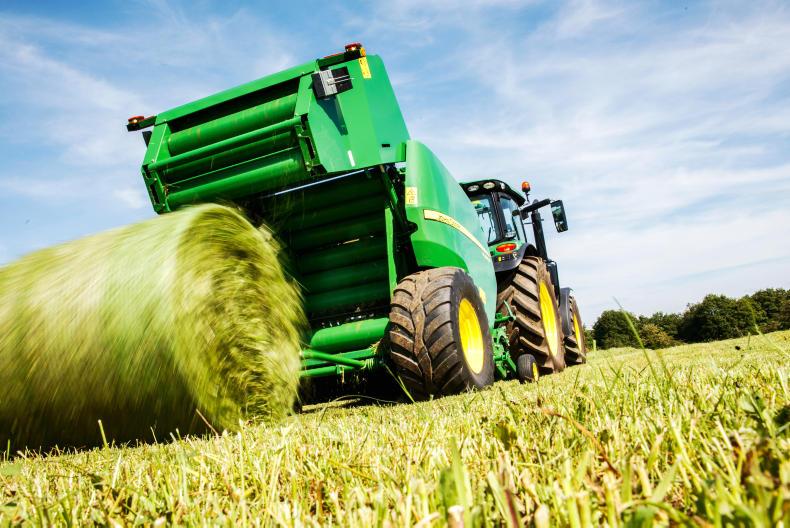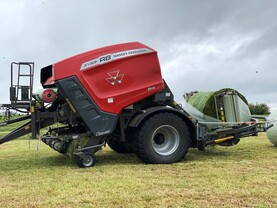There are many ways the quality of bale can be affected, from the operator to the condition of the grass being fed into the baler.
The operator has control over the machine settings and the way in which the machine is used in the field. Before leaving the yard, the operator should undertake all possible checks and maintenance on the machine. A well-minded machine will make better bales.
Once in the field, the operator has control of the forward speed and the baler settings. When baling silage, the end user usually wants the tightest bale possible.
This can only be done by matching the forward speed to the sward size in the field.
Modern balers claim to be able to bale at massive forward speeds up to 40km/h; this may be true in lighter, drier crops that rarely occur on this island.

Chopper balers are often used for grass silage. Fixed-knife choppers use a rotor to pull the grass through a fixed bank of knives. Between 11 and 14 knives are normally used, giving a nominal chop length of 85mm to 110mm.
Some balers can be fitted with up to 23 knives. Increases in bale density are variable, depending on grass type, dry matter and sward presentation, but are normally in the region of about 10% over unchopped bales.
Chopped bales are easier to distribute at feeding but the chop length is much longer than conventional precision or double-chop silage.
Forward speeds ranging from 10km/h to 20km/h are common and acceptable when the conditions allow. Ensure the sward is full width when entering the mouth of the baler. This ensures production of firm and well-shaped bales, which results in heavier but fewer bales per acre, reducing baling and wrapping costs.
Sward width and forward speed
Not only should the sward be the full width but it should be evenly distributed across the width. This removes the issue of having to change forward speed constantly to keep the feed even. There can be issues in field where the grass cover differs drastically before it is mown.
Swath width can be varied by setting the swath formers on mower conditioners or tedders/rakes. Hay-bob-type machines need careful setting (forward speed, PTO speed, swath doors) to avoid producing very uneven swaths and also the dreaded ropes.

 Once in the bale, the grass should be wrapped as quickly as possible, ideally within two to three hours of baling. Well-shaped bales are easier to wrap properly and to handle without causing damage. In Ireland, four layers of film are typically used, although in countries such as Sweden six layers are the norm.
Once in the bale, the grass should be wrapped as quickly as possible, ideally within two to three hours of baling. Well-shaped bales are easier to wrap properly and to handle without causing damage. In Ireland, four layers of film are typically used, although in countries such as Sweden six layers are the norm.
Six layers should be used for silage that is greater than 30% DM or when wrapping silage temperatures higher than 20°C.
Gentle handling of bales before and after wrapping is essential in order to maintain the shape of the bales and the integrity of the seal provided by the plastic film. Ideally, wrap bales at final storage point. This reduces the risk of post-wrapping stubble/transporting damage to airtight seal. However, even these unwrapped bales need to be handled gently as rough handling can misshape the bales and make them more difficult to wrap perfectly. Transporting unwrapped bales on a spike can readily misshape the bales. Any handling of wrapped bales should be within a day of wrapping.
Making the perfect bale is a mixture of all of the factors mentioned above, but with a correctly set baler being driven by a competent operator, high-quality bales of silage will be produced consistently.
Read more
Special focus: baled silage
Full coverage: silage 2017
There are many ways the quality of bale can be affected, from the operator to the condition of the grass being fed into the baler.
The operator has control over the machine settings and the way in which the machine is used in the field. Before leaving the yard, the operator should undertake all possible checks and maintenance on the machine. A well-minded machine will make better bales.
Once in the field, the operator has control of the forward speed and the baler settings. When baling silage, the end user usually wants the tightest bale possible.
This can only be done by matching the forward speed to the sward size in the field.
Modern balers claim to be able to bale at massive forward speeds up to 40km/h; this may be true in lighter, drier crops that rarely occur on this island.

Chopper balers are often used for grass silage. Fixed-knife choppers use a rotor to pull the grass through a fixed bank of knives. Between 11 and 14 knives are normally used, giving a nominal chop length of 85mm to 110mm.
Some balers can be fitted with up to 23 knives. Increases in bale density are variable, depending on grass type, dry matter and sward presentation, but are normally in the region of about 10% over unchopped bales.
Chopped bales are easier to distribute at feeding but the chop length is much longer than conventional precision or double-chop silage.
Forward speeds ranging from 10km/h to 20km/h are common and acceptable when the conditions allow. Ensure the sward is full width when entering the mouth of the baler. This ensures production of firm and well-shaped bales, which results in heavier but fewer bales per acre, reducing baling and wrapping costs.
Sward width and forward speed
Not only should the sward be the full width but it should be evenly distributed across the width. This removes the issue of having to change forward speed constantly to keep the feed even. There can be issues in field where the grass cover differs drastically before it is mown.
Swath width can be varied by setting the swath formers on mower conditioners or tedders/rakes. Hay-bob-type machines need careful setting (forward speed, PTO speed, swath doors) to avoid producing very uneven swaths and also the dreaded ropes.

 Once in the bale, the grass should be wrapped as quickly as possible, ideally within two to three hours of baling. Well-shaped bales are easier to wrap properly and to handle without causing damage. In Ireland, four layers of film are typically used, although in countries such as Sweden six layers are the norm.
Once in the bale, the grass should be wrapped as quickly as possible, ideally within two to three hours of baling. Well-shaped bales are easier to wrap properly and to handle without causing damage. In Ireland, four layers of film are typically used, although in countries such as Sweden six layers are the norm.
Six layers should be used for silage that is greater than 30% DM or when wrapping silage temperatures higher than 20°C.
Gentle handling of bales before and after wrapping is essential in order to maintain the shape of the bales and the integrity of the seal provided by the plastic film. Ideally, wrap bales at final storage point. This reduces the risk of post-wrapping stubble/transporting damage to airtight seal. However, even these unwrapped bales need to be handled gently as rough handling can misshape the bales and make them more difficult to wrap perfectly. Transporting unwrapped bales on a spike can readily misshape the bales. Any handling of wrapped bales should be within a day of wrapping.
Making the perfect bale is a mixture of all of the factors mentioned above, but with a correctly set baler being driven by a competent operator, high-quality bales of silage will be produced consistently.
Read more
Special focus: baled silage
Full coverage: silage 2017


 Once in the bale, the grass should be wrapped as quickly as possible, ideally within two to three hours of baling. Well-shaped bales are easier to wrap properly and to handle without causing damage. In Ireland, four layers of film are typically used, although in countries such as Sweden six layers are the norm.
Once in the bale, the grass should be wrapped as quickly as possible, ideally within two to three hours of baling. Well-shaped bales are easier to wrap properly and to handle without causing damage. In Ireland, four layers of film are typically used, although in countries such as Sweden six layers are the norm. 





 This is a subscriber-only article
This is a subscriber-only article












SHARING OPTIONS: